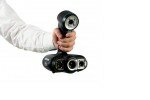According to the motto ‘everything from one source’, in addition to standard parts for temperature, mould closing force and end position control, Meusburger now also offers sensors for cavity pressure measurement. These are compatible with all piezoelectric pressure sensors as well as their components currently available on the market. The range includes two types each for direct and indirect measurement as well as suitable mounting accessories and connection cables – as usual available from stock with simple CAD data download from the Meusburger web shop.
Meusburger E 6740 Cavity pressure sensor for direct measurement. Source: Meusburger
The cavity pressure is an important parameter in process monitoring during plastic injection moulding. Pressure sensors are therefore indispensable for comprehensive mould monitoring. The use of high-quality piezoelectric sensors leads to optimal process quality and increases part quality sustainably.
Functional principle and uses of cavity pressure sensors
Cavity pressure sensors make it possible to convert the pressure in the cavity to a measurable charge by means of the piezoelectric effect. The sensors are equipped with high-precision quartz crystals (SiO2 or α-quartz) which release a charge under the influence of pressure or force. This charge, amplified by a charge amplifier, provides precise information about the pressure applied to the sensor and makes it possible to monitor the exact cavity pressure in the injection moulding process. The ideal installation position in the mould depends on the application. For example, for general monitoring and process optimisation, the sensor is placed as close as possible to the sprue or on a thicker section of the moulded part. Other typical applications are strength monitoring and monitoring or controlling viscosity, compression or shrinkage.
Direct and indirect cavity pressure sensors
Depending on the application, there are two types of pressure sensors: direct and indirect sensors, which serve for direct or indirect pressure measurement.
Meusburger E 6740 Cavity pressure sensor for direct measurement
For direct measurement, the pressure sensor is inserted directly into the cavity so the cavity pressure can be measured directly in the respective area. When pressure is applied, the sensor delivers an electrical charge in the pC unit (Picocoulomb), which is then converted into a change of pressure (bar) through the specified sensor sensitivity (pC/bar).
Meusburger E 6750 Cavity pressure sensor for indirect measurement
The indirect measurement of the cavity pressure is carried out via a force sensor which is located outside the cavity and is indirectly actuated by a force. Unlike direct sensors, the cavity pressure is transmitted to the sensor as a force via an ejector pin. In response to this force, the sensor emits an electrical charge, which is then converted into a change of force (N) through the specified sensor sensitivity (pC/N). This change of force combined with the surface of the ejector is used to calculate the pressure change.
Meusburger E 6750 Cavity pressure sensor for direct measurement. Source: Meusburger
Source:Meusburger
More information:
On Meusburger’s official website

 TwinCAT Vision – Machine vision easily integrated into automation technology
TwinCAT Vision – Machine vision easily integrated into automation technology
 Creaform Launches The Next Generation of GO!SCAN 3D Portable Scanners
Creaform Launches The Next Generation of GO!SCAN 3D Portable Scanners
 Hexagon Metrology Rolls Out PC-DMIS 2014.1
Hexagon Metrology Rolls Out PC-DMIS 2014.1
